
Animal attractions and shows often went hand in hand with fairs and
amusement parks, and with the rise of theme parks, animal shows became a
staple attraction in parks around the world. The success of marine life
parks like Marineland and SeaWorld led to many theme parks introducing
marine mammal shows often featuring Atlantic bottle nose dolphins or
California sea lions as the star performers. With changing times and
tastes, animal shows were retired from most theme parks through the
1990's.
|
| |
|
|
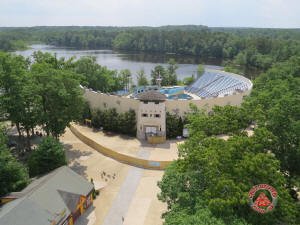 |
By the end of the 20th century, few theme parks that weren't specialty
marine life parks still had any kind of marine life shows. Most parks
phased out these kind of shows anymore.
Six
Flags Great Adventure was fortunate enough to have one of the largest
pools of any theme park, and the Aqua Spectacle continued operation into
the new millennia, offering dolphin shows on and off until 2011, and
then continuing with sea lion shows until 2014.
The stadium was
showing signs of its 40 years hosting millions of guests and the salt
water required for the marine mammals added to the wear and tear to the
structure.
The stadium required extensive and expensive
maintenance to continue operating, and with dwindling demand for marine
shows in the park, it soon became obvious that demolition was the most
sensible course of action, opening up new area for development of new
attractions.
In July of 2015 a fence was erected around the Aqua
Stadium as preparation for demolition was underway.



 |
 |
| |
|
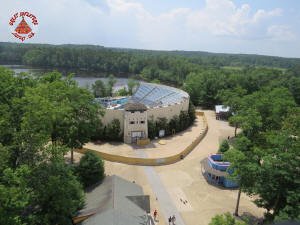 |
 |
| |
|
 |
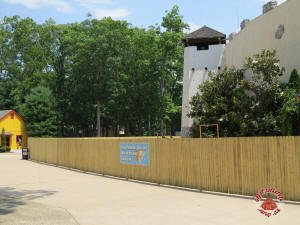 |
| |
|
 |
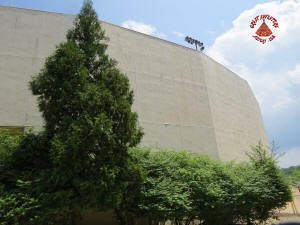 |
| |
|
 |
 |
| |
|
 |
 |
|
|
|
 |
 |
| |
|
 |
 |
| |
|
 |
 |
| |
|
 |
 |
| |
|
|
 |
 |
 |
| |
|
|
 |
 |
 |
| |
|
|
 |
The walls of the Aqua Stadium were really starting to show their age.
The last full remodel of the building had been done in 1993 when the new
tower was added along with some stone veneer as it became Fort
Independence when it was incorporated into the adjacent fountain area as
part of the colonial themed park entrance area. |
 |
| |
|
|
 |
 |
 |
| |
|
|
 |
Over the course of the 22 years since the remodel to Fort Independence,
the decorative magnolia and spruce trees planted around the exterior of
the building had grown quite large, covering up some of the
deteriorating wall boards. |
 |
| |
|
 |
 |
| |
|
|
 |
 |
 |
| |
|
|
 |
For most of the months of July and August there was little visible
change to the building, with most of the work concentrating on the
utility aspects hidden from view. Work was also being done in the park's
off hours to minimize disruptions to operations and guests during the
peak of the summer season. Once power and water had been cut off safely,
the real demolition would begin as the park went into weekend only
operations for the fall. |
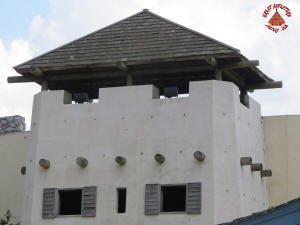 |
| |
|
 |
 |
| |
|
|
 |
 |
 |
| |
|
|
 |
 |
 |
| |
|
|
 |
 |
 |
| |
|
|
 |
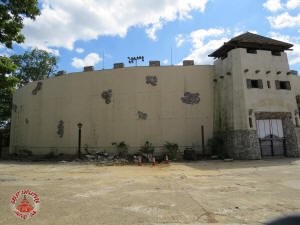 |
 |
| |
|
|
 |
 |
 |
| |
|
|
 |
The beginning of September saw the major demolition of the Aqua Stadium
start. Large sections of the massive walls and bleachers were removed,
exposing the steel framework and infrastructure hidden below. The view
was a dramatic change for everyone entering the park as the huge
structure that had been there since opening day in 1974 began to come
down.
The large concrete tanks once hidden below the seating
were now visible. These tanks were part of the water filtration and
treatment system, as well as salinization tanks which produced the
saltwater required to keep marine mammals.
The newly opened
structure also exposed the rusted framework that held the plaster wall
panels on the outside of the building, revealing the effects of time and
saltwater on the structure. The concrete and steel were in generally
good condition considering how long they had been exposed to the
elements.
The demolition equipment made quick work of the
aluminum benches and the steel framework, but the massive reinforced
concrete tanks would take more time and effort to demolish. |
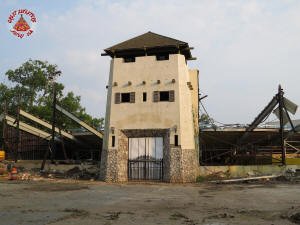 |
| |
|
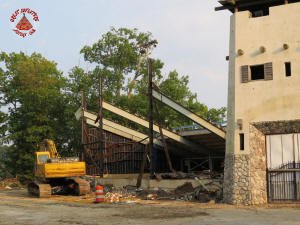 |
 |
| |
|
 |
 |
| |
|
 |
 |
| |
|
 |
 |
| |
|
|
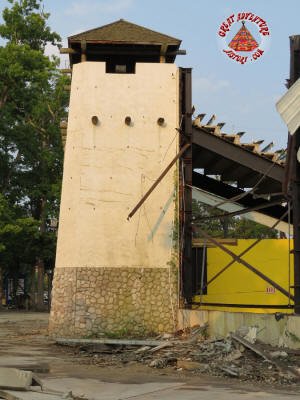 |
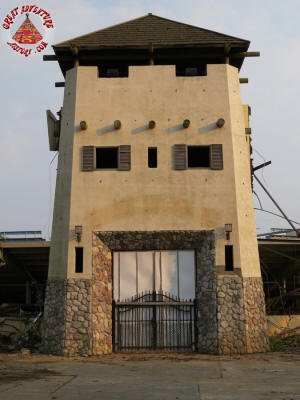 |
 |
| |
|
|
 |
As the structure came down, memories of better days could be found in
the debris. The central pole that used to be part of the 100' high dive
platform still stood above the rubble. The windows of the old sound
booth where the thousands of dolphin, sea lion, and high dive shows had
been run from somehow managed to fall more than 40 feet to the ground
without breaking. The empty bleachers that had held capacity crowds for
so many years now sat in twisted piles after being torn from their
concrete bases.
 |
 |
| |
|
 |
 |
| |
|
 |
 |
| |
|
 |
 |
| |
|
|
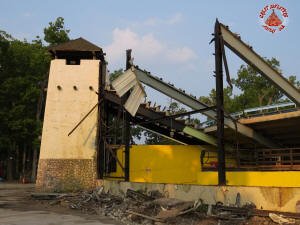 |
 |
 |
| |
|
|
 |
 |
 |
| |
|
|
 |
 |
 |
| |
|
|
 |
 |
 |
| |
|
|
 |
 |
 |
| |
|
|
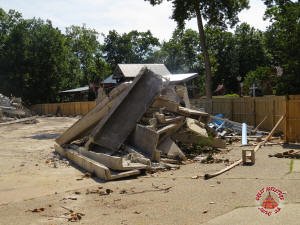 |
 |
 |
| |
|
|
 |
As demolition was
happening, the crew sorted materials for recycling. Piles were made of
the aluminum benches, the steel support beams, and the concrete decking
materials so the could be hauled off to the proper facilities where they
could be turned into new building materials with little waste going into
a general landfill facility. |
 |
| |
|
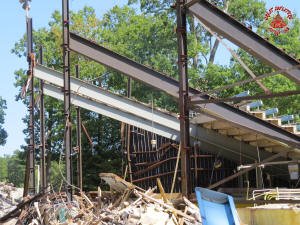 |
 |
| |
|
|
 |
 |
 |
| |
|
|
 |
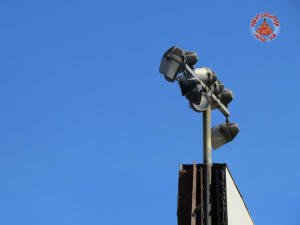 |
 |
| |
|
|
 |
 |
 |
| |
|
|
 |
 |
 |
| |
|
|
 |
 |
 |
| |
|
|
 |
By mid-September 2015
the structure of the Aqua Stadium had been demolished to the point that
it was no longer visible from the Fountain area except for the mast from
the diving platform. Much of the debris had already been carted away
with only a few piles of scrap materials remaining. |
 |
| |
|
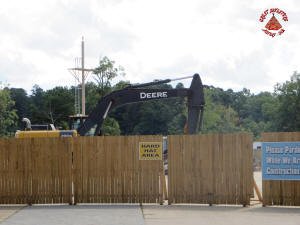 |
 |
| |
|
|
 |
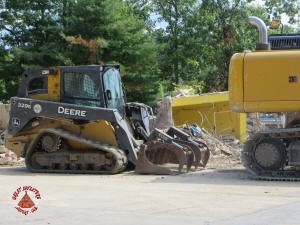 |
 |
| |
|
|
 |
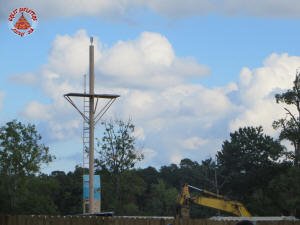 |
 |
| |
|
|
 |
The concrete pool at
the center of the stadium was the last part of the demolition process.
The 16 foot deep reinforced concrete pool was a larger challenge for the
demolition process, with the concrete needing to be broken into smaller
pieces for removal. |
 |
| |
|
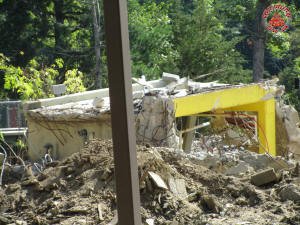 |
 |
| |
|
|
 |
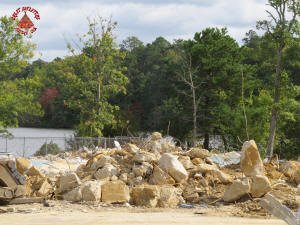 |
 |
| |
|
|
 |
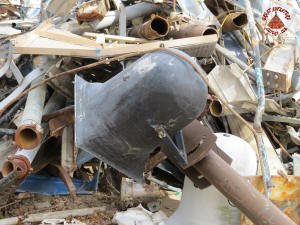 |
 |
| |
|
|
 |
As September wore on
the pool was being reduced to rubble slowly but surely. Chunks of
concrete and twisted rebar were all that remained as the crews kept
chipping away at the massive structure. |
 |
| |
|
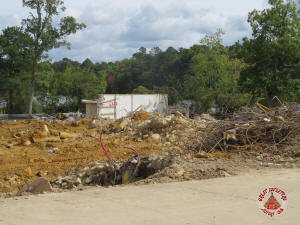 |
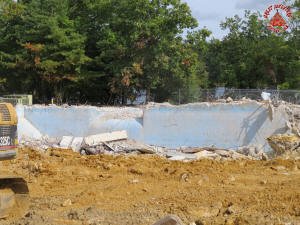 |
| |
|
|
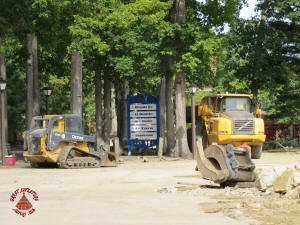 |
 |
 |
| |
|
|
 |
 |
 |
| |
|
|
 |
 |
 |
| |
|
|
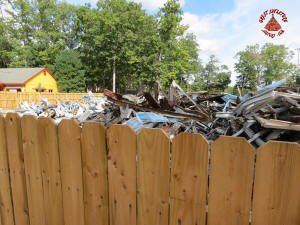 |
 |
 |
| |
|
|
 |
With the start of
October the final stages of demolition were happening. The pool was
mostly gone, with just some final site cleanup occurring to prepare the
ground for the future. |
 |
| |
|
 |
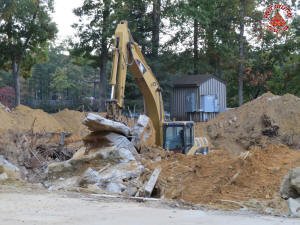 |
| |
|
|
 |
 |
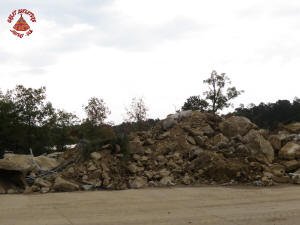 |
| |
|
|
 |
 |
 |
| |
|
|
 |
As the 2015 season drew to a close with the end of October, the Aqua
Stadium became part of the park's history.
Big changes would be
coming in the next season with the introduction of the Joker roller
coaster on the former site of what had been the most popular attraction
in the history of Great Adventure. |
 |
| |
|
 |
 |
| |
|
|
 |
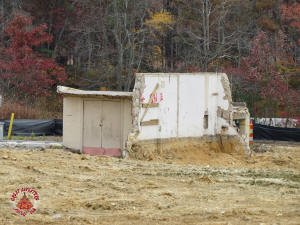 |
 |
| |
|
|
| Original Spotlight: March 14,
2019. GAH Reference#: SHOW-1974-004 |
| |
|
|




